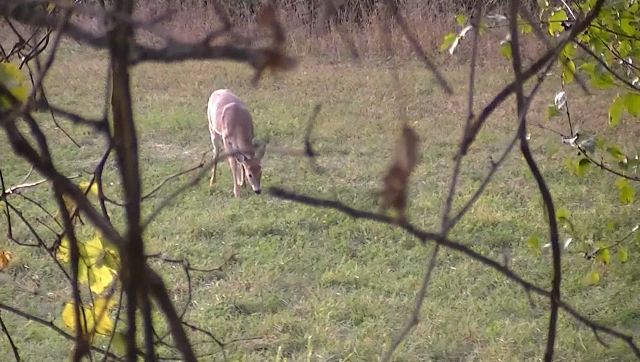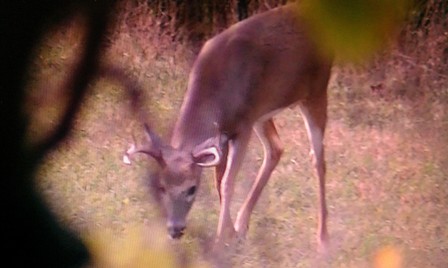Then & Now
Category: article
Nov 28th, 2012 by OutdoorsFIRST
Modified Nov 28th, 2012 at 12:00 AM
My Dad has always been a very humble and modest man. Never one to brag, he’s laid down some serious racked bucks in his time and caught some very impressive fish over his years. His idea of a “BIG” buck has nothing to do with the size of the rack, rather the size of the body, but I can vouch that he’s killed BIG bucks seen from both sides of the fence. Seems the ideology of what constitutes as a “BIG” buck over the last 20 years or so has evolved into terms of antler size, based on spread, height, mass and character and less so having to do with the body of the animal. The motivation my father was raised to hunt by was focused more so on harvesting for the meat, and if luck would have it that a big buck would cross his path, well, that was just icing on the cake. Even when the monarch of the woods would fall to the bark of his shotgun, there would be no magazine cover photo shoot; no expectations for kudos or words wasted glorifying his prowess.
 |
|
|
|
What motivates a whitetail hunter in the deer woods is always worthy of respect in my opinion. To the hunter who hunts for meat and cares little for the crown on a buck’s head, their traditional perspective is admirable. Rare is it to find an original shoulder mount, or head mount rather, dating back before the 1980’s. In most cases, racks were wedge off and nailed to a board and hung on rafters of a barn, hence the term, “barn-burners”.
Things are a bit different in the Whitetail world these days. The interest in bow hunting has grown enormously in the last twenty years, and so have the numbers of large Whitetail bucks registered across much of the country. The motivation behind the pursuit of many Whitetail hunters seems to have evolved into a much narrower common goal, the quest of downing a “book” buck. There are several well-known scoring clubs in North America that use a scoring system based on the measurements of animal’s features, specific to individual species, in order to determine the ranking of the animal within the club’s record books. Two particular clubs have really become staple benchmarks across the Whitetail world, and those are the Pope & Young, which is tailored towards the bowhunting world, and the Boone & Crockett Club, which is widely known and recognized as the most prestigious of animal scoring record books in all of North America.
The Boone & Crockett Club is actually the pioneer in developing a means of measurement to rank Big Game animals across the world as a means of rank in the record books. The actual mission statement directly from the Boone & Crockett Club states: “It is the mission of the Boone and Crockett Club to promote the conservation and management of wildlife, especially big game, and its habitat, to preserve and encourage hunting and to maintain the highest ethical standards of fair chase and sportsmanship in North America.” Today, The Longhunters Society, Safari Club International and the Pope & Young Club all maintain the same standard scoring system designed originally by the Boone & Crockett Club as a means of maintaining integrity across the majority of Big Game scoring organizations recognized today. While measurement systems vary based on the specie of the animal, when it comes to scoring Whitetails, measurements are in terms of inches of a bucks rack is the standard metric recorded.
To have your buck inducted into the Pope & Young record books, an archery-killed Typical Whitetail rack must measure at least 125-inches after a 60-day drying period from the date of the kill. A Non-Typical archery-killed Whitetail rack must measure at least 155-inches after a 60-day drying period.
 |
|
|
|
Today, many Whitetail hunters benchmark their pursuits after Boone & Crockett Club score minimum requirement of 170-inches of antler after a 60-day drying period, or 195-inches of antler to be inducted as a Non-Typical Whitetail deer after the 60-day drying period. The prestige of this club is in terms of being the original pioneer in developing the standard means of measuring animals, as well as having a substantially higher minimum score required to be entered into the record books.
One thing I’ve really noticed more and more over the years is that a buck’s score has become a sort of status symbol for many hunters today. A Whitetail buck may take three years just to reach a minimum score from any of the scoring clubs out there today and even that is a stretch to say the least. Typically, to reach a fully mature age and develop a truly peak potential rack, bucks need at least 4.5 to 5.5 years. With every year, a deer’s wariness will make them all the more difficult to get an edge on and put them within range to successfully harvest with a bow or a gun. The challenge of taking a “book” buck just once in a lifetime is a feat that none to many can attest to having accomplished, so have a number of “book” bucks to a hunters credit can say a lot about that hunter.
There is a reality that may be argued by some, but certainly agreed to by many more, and that has to do with situational terms under which a hunter who has bagged numerous “book” bucks was afforded to hunt by. Land, for instance, may be far and wide, but it comes with a large price tag. The world is full of private land owners, but severely over-populated by folks who aren’t. The ability to buy land suitable to managing a herd of Whitetail’s takes money to invest, but a lot of work, also. Credit is due where it belongs and I believe a land owner’s return on their investment in the way of big bucks is well-deserved and admirable to the utmost.
For some landowners, however, their tracts may not be large enough to effectively manage a Whitetail herd. An association called QDMA (Quality Deer Management Association) is responsible for growing an enterprise of followers who proudly post their lands with QDMA signs signifying their harvest standards for bucks. Neighbors upon neighbors interested in managing a deer herd, especially those parcels of land too small to effectively hold deer through the hunting seasons, have been known to adopt the QDMA approach and collaboratively teamed up to improve the quality of the bucks they see roaming their lands.
So what about the more traditional hunters out there who aren’t as caught up in the size of a deer’s rack or a status symbol in the Whitetail world, even if it’s within the borders of small towns? While I, too, may get caught up in the scoring potential of a deer and certainly to aspire to one day harvest a Boone & Crockett buck, I only know how it feels to live on the other side of the fence. I think it’s silly to judge a person’s success story based purely off the size of the bucks rack.
I know first-hand what it takes to prepare for each and every upcoming deer hunting season. How I approach the season may be different than how many others do, but the time and energy invested into pre-scouting, setting up stands, and simply making time to hunt can be overwhelming at times. To put a plan together and hunt a set you’ve put much thought into is a gamble to see if you were right about your hunches and if you made yourself invisible enough. When that plan comes together and a buck comes in on a string just the way you envisioned it, I would respect any hunter who chose to take that deer as a reward for their efforts if it gave them the amount of satisfaction they wanted out of the hunt.
It’s important to remember where you started when you first began hunting Whitetails. I believe the future of many hunters first getting introduced to the sport will adopt the more modern approach; waiting on THE ONE, as it seems like that’s the direction many hunters today are heading. It’s advertised everywhere you turn in the hunting industry, the “Let him go, let him grow” mentality.
For me, as a person who’s chosen to share my hunts and kills in the limelight over the last couple years, I expect to hear criticisms at times. Albeit, unwarranted in many instances, open-ended thoughts from folks really shed a light on the direction hunting is headed at this point in my hunting career. Just the other week, at a tavern in a small town far away from my home, I was congratulated by an individual for a respectable six-pointer I decided to take in late September in a CWD-DMU. While I by no means expected praise from anyone for my successful hunt, it was rewarding to be reminded of an evening in the treestand that I’ll remember the rest of my life. One thing I could have probably done without, however, was the follow up comment, “He could have used another year though…” Mind you, most deer will grow in another year, unless their so old they’re going downhill, but rarely do fair-chase
Whitetails live to such an extreme old age. So, surely my six-pointer would have grown substantially in another year, he would probably have grown profusely more in another two years, but that night I knocked him down he was just right for the taking and I am proud of my kill.
I fully respect and appreciate the way I was raised in the Whitetail woods. I was never made to feel that any deer I decided to harvest was anything less than worthy of a high-five and sincere congratulations. I never once questioned my growing passion for hunting Whitetail’s because I didn’t felt unrewarded after taking a buck off his feet. You have to start somewhere, and in the meantime, remember that everyone else who shares your passion for Whitetail hunting had to start somewhere, too. One thing we have to never lose sight of is that we’re all out there for one common bond, our passion for hunting Whitetails.